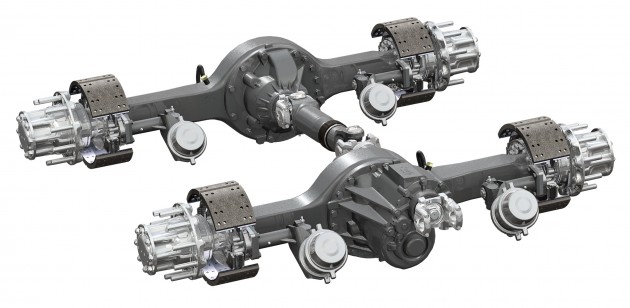How downspeeding can destroy your driveline
The trend towards downsped powertrains is unlikely to abate, since a 1% fuel economy gain can be achieved for every 100 rpm slower the engine runs. Several powertrain offerings have come out in recent years that downspeed 200 rpm, providing a 2% fuel savings, which can amount to about $2,200 per truck annually based on US fuel pricing.
But those savings can quickly vanish if your truck is stuck on the side of the road with a mangled driveline.
This is a legitimate concern, according to Mike Schwanzl, senior manager, field sales with Dana. Schwanzle outlined these issues to Truck News during a one-on-one briefing at the American Trucking Associations Management Conference & Exhibition earlier this month.

Downsped powertrains “need faster axle ratios to deliver the same horsepower to the drivline,” Schwanzl explained. “This brings with it the challenges of more torque in the drivetrain. As axle ratios go down numerically, the driveline torque increases.”
Dana claims a downsped engine at cruise speed increases torque in the driveline by 57%. Fortifying the driveline is the only way to protect it against the resulting long-term torque stresses.
Dana has introduced the new Spicer Advantek 40 tandem axle specifically to address this new challenge. It features the industry’s fastest axle ratios of 2.26:1, to handle the higher axle input torques resulting from lower engine rpms at cruise speeds.
The Advantek 40 is a more robust tandem axle than previous designs, which also weighs about 20 lbs lighter. It is coupled with the SPL 350 driveshaft and SPL inter-axle shaft to collectively provide a “fortified” driveline capable of handling the increased torque generated by downsped powertrains, Schwanzl explained. While the Advantek reduces weight by 20 lbs, the SPL 350 driveshaft actually adds 50, for a net loss of 30 lbs. However, Schwanzl pointed out the SPL 350 and SPL 250 have 40% greater torque carrying capability and twice the bearing life over competitive designs. He also noted a lighter-weight steer axle is in the works to gain back some of the weight added by the SPL 350’s heavier-duty u-joint.
Dana claims these are the only driveshafts and inter-axle driveshafts in the market today that can provide a million mile life expectancy in a downsped powertrain environment.
However, beefing up the driveline isn’t the only thing a fleet can do to reduce the risk of damage. Schwazl suggested fleets also torque-limit the engine through a software recalibration. This will minimize the risk of overloading the driveline in lower gears.
“We advocate a combined approach,” he said.
With fleets and OEMs pursuing even greater fuel economy, Schwazl said the trend towards slower-running engines and the higher torque loads they create is here to stay.
“We are hearing the OEMs want to move down towards 900 rpm cruise speeds, so torques will continue to rise,” he said. “We need to anticipate that and engineer solutions now to accommodate more torque in the driveline.”
In the meantime, since the concept of downspeeding is still relatively new, fleets need to ensure they’re spe’ing their drivelines appropriately. Schwazl said Dana saw a spike in equipment failures over the winter – especially in low-speed maneuvers – because customers paired downsped powertrains with traditional drivelines.
Some fleets now stuck with an incompatible system have gone so far as to retrofit their driveline components.
“We have retrofitted a couple of fleets but that’s expensive to do – it’s really not practical,” Schwazl said.
Dana has published a white paper that explores this issue in more detail. It can be found here.
Have your say
This is a moderated forum. Comments will no longer be published unless they are accompanied by a first and last name and a verifiable email address. (Today's Trucking will not publish or share the email address.) Profane language and content deemed to be libelous, racist, or threatening in nature will not be published under any circumstances.
Why not use planetary driveline? The other side of the pond has been using them for years at 120km/hr with no issues. All the torque is in the hubs, not the driveline. They have plenty of grades to climb.
This is another glaring example of how development and validation seem to lag behind product offerings in the truck industry. It’s sad but true. A first year engineering student could tell you that numerically lower rear axle ratios require more torque to be transmitted thru the transmission and drivelines. You are doing the same amount of work yet with less torque multiplication in the rear axle. But it has taken the industry 2 to 3 years to finally offer driveline solutions designed specifically for downsped engines and lower RAR’s which have been widely used by customers and promoted by OEMs.